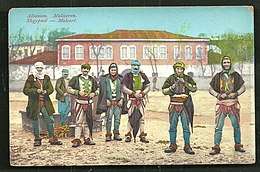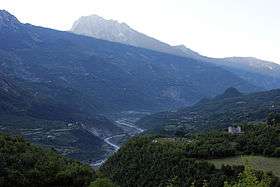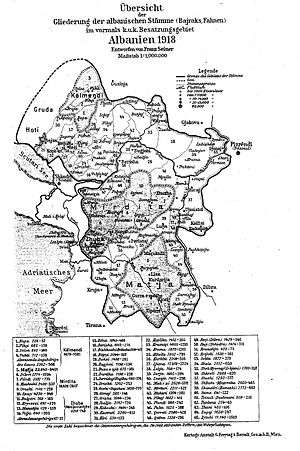Shala (tribe)
Shala is a historical tribe and region of northern Albania in the valley of the river Shalë, in the Dukagjin highlands. It was first mentioned in 1634, and oral tradition and archaeology confirms that their ancestors immigrated to the valley. At the end of the 19th century the tribe was Catholic and had ca. 3,000 members. Today, descendants are widespread in Kosovo.
| Part of a series on | ||||||||||||
| Albanian tribes | ||||||||||||
|---|---|---|---|---|---|---|---|---|---|---|---|---|
 | ||||||||||||
|
Tribes and regions
|
||||||||||||
|
Concepts |
||||||||||||
|
Culture
|
||||||||||||
Etymology
According to Robert Elsie, their name derives from the Albanian word shalës(inë), meaning "infertile land". The Shala name was recorded for the first time in Italian in 1634 as "Sciala". Albanian legends relate that the Shala share a common ancestor with the Shoshi and Mirdita (from three brothers, one who had saddle (Albanian: shalë), second had sieve (Albanian: shoshë) and third who had nothing wished to his brothers to have a good-day (Albanian: mirëdita).[1]
Geography

The tribal region is situated in northern Albania, in the valley of the river Shalë, north of the Drin and south of Theth, in the Dukagjin highlands.[2]
The Shala tribe is either divided into four bajraks: Theth, Pecaj, Lothaj and Lekaj, or three bajraks: Shala, Gemaj and Theth, the latter two considered tribes in their own right.[3]
Since the last decade of the 17th century the region of Kosovo and north-western Macedonia was settled by families belonging to Albanian tribes. The most intensive phase of this migration was between the middle of 18th century until the 1840s. This led to division of many tribes including Shala.[4]
Today in Kosovo, the Shala are concentrated primarily around Vučitrn, Mitrovica, and Trepça in the hilly region known as Shala e Bajgorës, Bajgora being the largest of their 37 settlements. They are divided into four clans or vllazni (brothers): the Gima, Peci, Maleti (related to the Lotaj in Albania proper) and the Lopçi. There are also good numbers of Shala in Isniq, Lluka e Epërme and Strellç in Ulët near Deçan, in Klina and Drenica.[5]
History
Origins
The legendary ancestor of the Shala was Zog Diti, while his brothers Mark Diti was that of the Shoshi and Mir Diti that of the Mirdita. There are also other founding traditions.[5] Results of historical and archaeological research confirm the claim of oral histories that ancestors of Shala came to the valley several centuries ago.[6] Some sources indicate that ancestors of Shala came to Albania from the region of Kuči (modern day Montenegro), which is why they are considered as related to Kuči.[7] Shala tribe was in conflict with Gashi tribe until they made peace in August 1879, based on sultan's order.[8] Russian scholar J. V. Ivanova (1922–2006) conducted research in northern Albania in 1956–58, and recorded from the locals that when the Shala had settled the Shala valley, they encountered the native "Mavriqi", from the Puka mountains in the 15th or 17th century, ultimately originating from the Pashtrik mountain near Prizren (in Kosovo) at the end of the 14th century.[3] The religion of the tribe was Catholic while the tribe had around 3,000 members at the end of 19th century.[9]
Ottoman period

During the late Ottoman period, the tribe of Shala was exclusively Catholic and it was a famous Albanian tribe. The tribe of Shala claimed it had four bajraktars (chieftains).[10] For the Shala the process of bloodguilt due to blood feuding was restricted to males of a household that were considered fair game.[11]
After the Young Turk Revolution (1908) and subsequent restoration of the Ottoman constitution, the Shala tribe made a besa (pledge) to support the document and to stop blood feuding with other tribes until November 6.[12]
In 1910, along with some other Albanian tribes, the Shala joined the Albanian revolt of 1910 and the fight between them against the Ottoman forces of Shevket Turgut Pasha attempting to reach Shkodër was fierce.[13][14]
During the Albanian revolt of 1911 on 23 June Albanian tribesmen and other revolutionaries gathered in Montenegro and drafted the Greçë Memorandum demanding Albanian sociopolitical and linguistic rights with two of the signatories being from Shala. In later negotiations with the Ottomans, an amnesty was granted to the tribesmen with promises by the government to build one to two primary schools in the nahiye of Shala and pay the wages of teachers allocated to them.[15]
Independent Albania
In 1913, Shala tribe joined Montenegrin forces during the Siege of Scutari. When Montenegrin forces began to disarm them after the city was captured, Shala tribe rebelled.[16]
In 1918, Austro-Hungarian census recorded 431 households and 2,512 inhabitants, inhabiting the settlements and surroundings of Abat, Lekaj, Lotaj, Nenmavriq, Nicaj, Pecaj and Theth.[17]
In 1926, Shala and Shoshi tribe again rebelled but this rebellion was suppressed by the gendarmes led by Muharrem Bajraktari and fighters from Dibra and Mat.[18] After World War II, the communists forced nationalist forces of Albania to retreat to Shala which they controlled throughout 1945 and 1946.[19]
Economy

Members of Shala tribe were very skillful in irrigation.[20] Branislav Nušić recorded that Shala was the poorest tribe of Albania with only small exception of around 400 families who lived in village Istinić, near Deçan.[21]
Religion
The patron saint of the Shala is Saint John the Evangelist, whose feast day was celebrated on 27 December.[17]
The religion of the tribe was Catholic while the tribe had around 3,000 members at the end of 19th century.[22] The descendants of the tribe in Kosovo today are Muslim.[23]
Notable people
- Isa Boletini - Albanian revolutionary and nationalist
- Ndok Gjeloshi - Albanian officer
- Mehmet Shpendi - Guerilla fighter
Gallery
 Man from Shala.
Man from Shala. Old Lahuta player in Shala.
Old Lahuta player in Shala.
See also
- Shalë municipality covered by the tribe
- Shala (surname)
- Tribes of Albania
References
- Miranda Vickers (1999). The Albanians: A Modern History. I.B.Tauris. pp. 103–. ISBN 978-1-86064-541-9. Retrieved 6 June 2013.
- Elsie 2003, p. 411: "Northern Albanian tribe and traditional tribal region. The Shala region is situated in the Dukagjini area north of the Drin River in the District of Shkodra, basically the valley of the Shala River south of Theth."
- Elsie 2015, p. 121.
- Kaser 2012, p. 124.
- Elsie 2015, p. 120.
- Helaine Silverman (1 January 2011). Contested Cultural Heritage: Religion, Nationalism, Erasure, and Exclusion in a Global World. Springer. p. 120. ISBN 978-1-4419-7305-4. Retrieved 1 June 2013.
Oral histories indicate that they arrived in the valley several centuries ago....... our historical and archeological data confirm these oral histories
- Prilozi za književnost, jezik, istoriju i folklor. Drzhavna štamparija Kralevine srba, khrbata i slovent͡sa. 1992. p. 156. Retrieved 4 June 2013.
За „близику " се са Кучима држе и арбанашка племена Шаљани и Берише јер су и њихови преци некада досељени из Куча .
- Đorđe Mikić (1988). Društvene i ekonomske prilike kosovskih srba u XIX i početkom XX veka. Srpska akademija nauka i umetnosti. p. 40. Retrieved 4 June 2013.
- Elsie 2003, p. 411.
- Gawrych 2006, pp. 31–32.
- Gawrych 2006, p. 33.
- Gawrych 2006, p. 159.
- Miodrag Marović (1 January 1995). Balkanski Džoker: Albanija i Albanci : istorijska hronika nastajanja i razvoja albanskog pitanja. Kulturni centar. p. 181. Retrieved 26 July 2013.
Sačekala su je planinska plemena Malisori, Gaši, Krasnići i Šalje
- Gawrych 2006, p. 178.
- Gawrych 2006, pp. 186–187.
- Armand Leon Baron von Ardenne; Hans Ferdinand Helmolt. Das Buch vom grossen Krieg. Union Deutsche Verlagsgesellschaft. p. 238. Retrieved 3 June 2013.
Приликом зау- зимања Скадра Црногорцима се придружило албан- ско племе Шаља, које су, међутим, они касније по- чели разоружавати. То је Шаљане увредило и изазвало на побуне и акције против црногорских је- диница и посада
- Elsie 2015, p. 119.
- Jason Tomes (26 September 2003). King Zog: self made monarch of Albania. Sutton. p. 95. ISBN 978-0-7509-3077-2.
- Glasnik Srpskog istorijsko-kulturnog društva "Njegoš" (in Serbian). Njegoš. 1996. p. 12. Retrieved 25 July 2013.
Предјаким комунистичкимснагама, албански националисти морали су да се повуку у племе Шаља. То племе остало је у њиховим рукама читаве 1945. и 1946. године.
- Glasnik Etnografskog muzeja u Beogradu. Muzej. 1937. p. 167. Retrieved 4 June 2013.
Шаљани су били врло вешти за извођење воде
- Branislav Đ Nušić (1966). Sabrana dela. NIP "Jež,". p. 242. Retrieved 4 June 2013.
Шаљани су најсиротније племе у целој Арбанији, од којих у богатству једва чине неки мали изузетак четири стотине кућа Шаљана који насеља- вају село Истиниће код Дечана.
- Elsie 2003, p. 411: "The Shala tribe, primarily Catholic, had a population of over 3,000 in the late 19th century."
- Elsie 2015, pp. 119–120.
Bibliography
- Elsie, Robert (2003). Historical Dictionary of Albania. Scarecrow Press. ISBN 978-0-8108-7380-3.CS1 maint: ref=harv (link)
- Elsie, Robert (2015). The Tribes of Albania: History, Society and Culture. Bloomsbury Publishing. ISBN 978-0-85772-586-8.CS1 maint: ref=harv (link)
- Gawrych, George (2006). The Crescent and the Eagle: Ottoman rule, Islam and the Albanians, 1874–1913. London: IB Tauris. ISBN 9781845112875.CS1 maint: ref=harv (link)
- Kaser, Karl (2012). Household and Family in the Balkans: Two Decades of Historical Family Research at University of Graz. LIT Verlag Münster. ISBN 978-3-643-50406-7.CS1 maint: ref=harv (link)